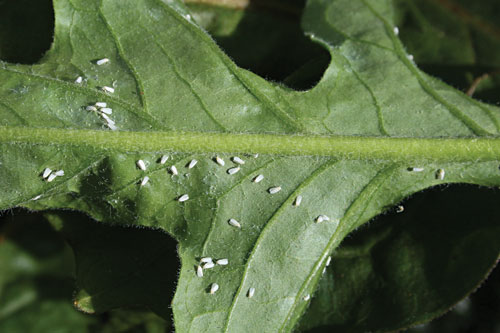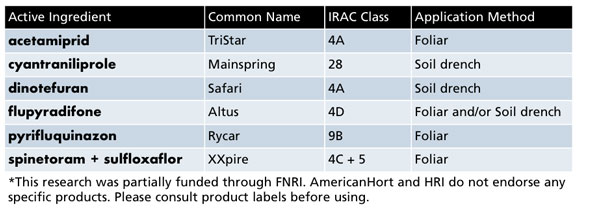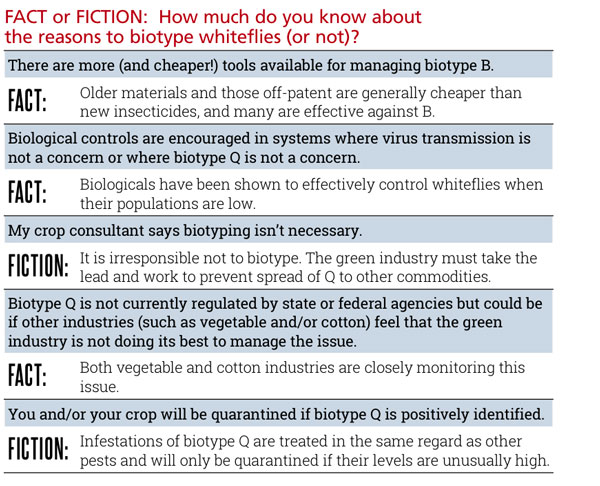5/1/2018
Whiteflies & Biotyping
Dr. Jill Calabro
As with most years, there will most likely be issues with whiteflies this spring and into the fall during poinsettia season. Some reports out of the Southeast have indicated increasing populations already. Biotype Q is still a big problem in greenhouse production and is considered a major threat to cotton, tomato and pepper production. In fact, tomato transplants are considered to be of greatest concern in movement of Q from controlled
environment production to outdoor establishment.
Along with Q, Biotype B whiteflies are increasingly reported resistant to insecticides. Here’s a quick refresher from Dr. Lance Osborne of the University of Florida and Dr. Cindy McKenzie, USDA-ARS, sent through AmericanHort:
Knowing the biotype
Three main whiteflies exist in both greenhouse and nursery production—sweet potato whitefly (Bemisia tabaci), greenhouse whitefly (Trialeurodes vaporarorium) and banded winged whitefly (T. abutiloneus). The three types share characteristics, such as:
- They feed on plant sap or phloem
- They lay eggs on the undersides of leaves
- Their life cycle can be as quick as three weeks if conditions are favorable
- They have no dormant stage and cannot tolerate freezing temperatures
- They have a very wide host range
Though they share some commonalities, some key differences exist. Sweet potato whitefly is the one that raises most concerns because it has distinct, biologically different biotypes, biotype B (also called MEAM1) and biotype Q (also called MED).
 Biotype B can be controlled using regular methods and even some biologicals. Fortunately, B is the most common biotype in the U.S. Biotype Q, on the other hand, is resistant to many classes of insecticides, such as some insect growth regulators, pyrethroids and some neonicotinoids.
Biotype B can be controlled using regular methods and even some biologicals. Fortunately, B is the most common biotype in the U.S. Biotype Q, on the other hand, is resistant to many classes of insecticides, such as some insect growth regulators, pyrethroids and some neonicotinoids.
Pictured: Sweet potato whitefly (Bemisia tabaci) adults on the leaf underside of a gerbera daisy.
Control of biotype Q isn’t necessarily more difficult than B, but may require different products. Some of Lance and Cindy’s latest research indicates the following, newer insecticides are effective against biotype Q:
Resistance management is essential. “We’ve been lucky over the last few years to get some new compounds that are effective for Q control, but we need to be diligent in our resistance management programs to preserve their utility,” said Lance.
On the other hand, products such as bifenthrin, pyriproxyfen, acephate, pymetrozine and others have reportedly failed to control Q, but still control B in many sites. Biological controls can be effective against whitefly if they’re applied preventively. They can help you stay ahead of whiteflies, but don’t provide the needed quick knockdown of large populations.
 The clear benefit of knowing which biotype is present is being able to better select the proper control measures. Some growers have opted to bypass the step of biotyping and rely on using only those products that are effective against both biotype B and Q. While effective, they reported significantly greater costs in their chemical programs as a result. Making the effort to find out which biotype is present can save you money and reduce the number of spray applications (through the use of biologicals).
The clear benefit of knowing which biotype is present is being able to better select the proper control measures. Some growers have opted to bypass the step of biotyping and rely on using only those products that are effective against both biotype B and Q. While effective, they reported significantly greater costs in their chemical programs as a result. Making the effort to find out which biotype is present can save you money and reduce the number of spray applications (through the use of biologicals).
So how do you know? Most importantly, B cannot be differentiated from Q without molecular tools, so specialists, such as Dr. McKenzie, are crucial for identification help. Fortunately, biotyping is a free service provided through Floriculture and Nursery Research Initiative (FNRI) funding, administered by USDA-ARS.
Why we should care
Biotype B is widely distributed throughout the U.S. in greenhouse, outdoor vegetable and cotton production. Until last year, biotype Q was only known to exist in greenhouse production—not in outdoor agriculture. That changed in 2016, when several outdoor, landscape sites in Palm Beach County, Florida, tested positive for a Q infestation. Other sites in Florida were identified as well.
This is alarming, as biotype Q would be especially problematic in vegetable and cotton production in southern regions. Q’s insecticide resistance would severely burden those industries, potentially limiting our food and fiber supplies. Not surprisingly, the vegetable and cotton industries are carefully monitoring these new developments.
State regulators are as well. USDA APHIS has responded with the reinstatement of the whitefly biotype Q task force (acronym WTF-Q) with the goal of bringing together folks from industry, research and regulatory units to address the concerns. AmericanHort and Horticultural Research Institute (HRI) participate on the task force, representing the green industry.
More than anything, the risk of biotype Q spreading in outdoor agriculture and to other crops justifies the need for diagnosis to ensure proper treatment. It’s more difficult to control than other whiteflies, especially biotype B. GT

Dr. Jill Calabro is Research & Science Programs Director for AmericanHort.